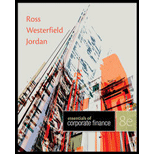
Essentials of Corporate Finance
8th Edition
ISBN: 9780078034756
Author: Stephen A. Ross, Randolph W. Westerfield, Bradford D. Jordan
Publisher: MCGRAW-HILL HIGHER EDUCATION
expand_more
expand_more
format_list_bulleted
Question
Chapter 15.9, Problem 15.9BCQ
Summary Introduction
To determine: The arguments against the shelf registration
Introduction:
The registration that is permitted under the Securities and Exchange Commission (SEC) rule of 415 is a shelf registration. The shelf registration lets the firm to register all the issues that it wishes to sell within 2 years at a time.
Expert Solution & Answer
Want to see the full answer?
Check out a sample textbook solution
Students have asked these similar questions
What does the term “liquidity” refer to in finance?A. The return on investmentB. The volatility of a securityC. The ease of converting assets into cashD. The interest rate charged by banks
Which of the following is a short-term financial decision?A. Issuing new sharesB. Capital budgetingC. Inventory managementD. Buying new machinery
I need help in this finance question!
What does the term “liquidity” refer to in finance?A. The return on investmentB. The volatility of a securityC. The ease of converting assets into cashD. The interest rate charged by banks
Chapter 15 Solutions
Essentials of Corporate Finance
Ch. 15.1 - What is venture capital?Ch. 15.1 - Prob. 15.1BCQCh. 15.2 - Prob. 15.2ACQCh. 15.2 - Prob. 15.2BCQCh. 15.3 - Prob. 15.3ACQCh. 15.3 - Prob. 15.3BCQCh. 15.4 - Prob. 15.4ACQCh. 15.4 - Prob. 15.4BCQCh. 15.5 - Prob. 15.5ACQCh. 15.5 - Prob. 15.5BCQ
Ch. 15.6 - Prob. 15.6ACQCh. 15.6 - Prob. 15.6BCQCh. 15.7 - Prob. 15.7ACQCh. 15.7 - Prob. 15.7BCQCh. 15.8 - Prob. 15.8ACQCh. 15.8 - Prob. 15.8BCQCh. 15.9 - Prob. 15.9ACQCh. 15.9 - Prob. 15.9BCQCh. 15 - Prob. 15.1CCh. 15 - Prob. 15.2CCh. 15 - Prob. 15.3CCh. 15 - Prob. 15.4CCh. 15 - Prob. 15.5CCh. 15 - What has been presented as a reason why stock...Ch. 15 - Prob. 15.7CCh. 15 - Prob. 15.8CCh. 15 - Prob. 15.9CCh. 15 - Debt versus Equity Offering Size. In the...Ch. 15 - Debt versus Equity Flotation Costs. Why are the...Ch. 15 - Prob. 3CTCRCh. 15 - Prob. 4CTCRCh. 15 - Prob. 5CTCRCh. 15 - Prob. 6CTCRCh. 15 - Prob. 7CTCRCh. 15 - Prob. 8CTCRCh. 15 - Prob. 9CTCRCh. 15 - Prob. 10CTCRCh. 15 - Prob. 1QPCh. 15 - Prob. 2QPCh. 15 - Prob. 3QPCh. 15 - Prob. 4QPCh. 15 - Prob. 5QPCh. 15 - Prob. 6QPCh. 15 - Prob. 7QPCh. 15 - Prob. 1CCCh. 15 - Prob. 2CCCh. 15 - Prob. 3CCCh. 15 - Prob. 4CC
Knowledge Booster
Similar questions
- Which of the following is a characteristic of a bond?A. Ownership in a companyB. Residual claimC. Fixed income investmentD. Unlimited liability Need help urgenarrow_forwardPlease don't solve with incorrect values . i will give unhelpful.arrow_forwardWhich of the following is a characteristic of a bond?A. Ownership in a companyB. Residual claimC. Fixed income investmentD. Unlimited liabilityarrow_forward
- If the Net Present Value (NPV) of a project is positive, it means:A. The project will break evenB. The project is not financially viableC. The project is expected to add value to the firmD. The payback period is very short need help!!arrow_forwardi need help!!If the Net Present Value (NPV) of a project is positive, it means:A. The project will break evenB. The project is not financially viableC. The project is expected to add value to the firmD. The payback period is very shortarrow_forwardDon't use ai. If the Net Present Value (NPV) of a project is positive, it means:A. The project will break evenB. The project is not financially viableC. The project is expected to add value to the firmD. The payback period is very shorthelp mearrow_forward
- 6. If the Net Present Value (NPV) of a project is positive, it means:A. The project will break evenB. The project is not financially viableC. The project is expected to add value to the firmD. The payback period is very shortarrow_forwardno ai A stock’s beta coefficient measures its:A. Total riskB. Diversifiable riskC. Market risk relative to the overall marketD. Interest rate sensitivityarrow_forwardWhich of the following ratios is used to measure a company’s profitability?A. Current RatioB. Quick RatioC. Return on Equity (ROE)D. Debt to Equity Ratioarrow_forward
- Diversification is a strategy used to:A. Increase total riskB. Eliminate systematic riskC. Increase expected returnsD. Reduce unsystematic riski need help!!arrow_forwardDiversification is a strategy used to:A. Increase total riskB. Eliminate systematic riskC. Increase expected returnsD. Reduce unsystematic riskarrow_forwardI need answer !! What is the effect of compounding interest?A. It decreases total interest earned over timeB. It keeps the interest constantC. It increases interest earned over time by earning interest on interestD. It applies only to loans, not investmentsarrow_forward
arrow_back_ios
SEE MORE QUESTIONS
arrow_forward_ios
Recommended textbooks for you
- Business/Professional Ethics Directors/Executives...AccountingISBN:9781337485913Author:BROOKSPublisher:Cengage
- Business Its Legal Ethical & Global EnvironmentAccountingISBN:9781305224414Author:JENNINGSPublisher:Cengage
 EBK CONTEMPORARY FINANCIAL MANAGEMENTFinanceISBN:9781337514835Author:MOYERPublisher:CENGAGE LEARNING - CONSIGNMENT
EBK CONTEMPORARY FINANCIAL MANAGEMENTFinanceISBN:9781337514835Author:MOYERPublisher:CENGAGE LEARNING - CONSIGNMENT



Business/Professional Ethics Directors/Executives...
Accounting
ISBN:9781337485913
Author:BROOKS
Publisher:Cengage

Business Its Legal Ethical & Global Environment
Accounting
ISBN:9781305224414
Author:JENNINGS
Publisher:Cengage


EBK CONTEMPORARY FINANCIAL MANAGEMENT
Finance
ISBN:9781337514835
Author:MOYER
Publisher:CENGAGE LEARNING - CONSIGNMENT